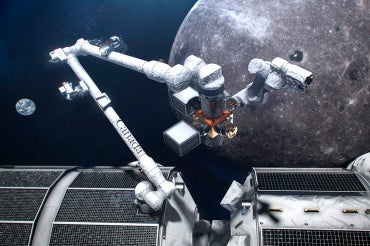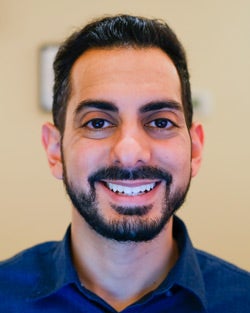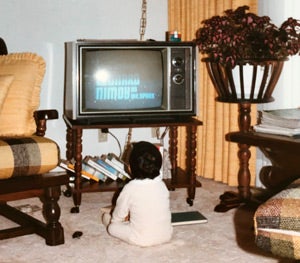U of T alum helps prepare Canadarm3 for lunar orbit

An artist's rendering of Canadarm3 on the Lunar Gateway (photo by CSA, NASA)
Published: August 14, 2023
Since watching Star Trek as a young boy in his parents’ living room, University of Toronto alumnus Jamil Shariff has dreamed of exploring strange new worlds – and boldly going where no one has gone before.
"Science fiction definitely sparked my interest in what the future of humanity would look like, the exploration of space and the development of amazing new technologies,” says Shariff, who earned his PhD in astrophysics in 2015.

Formerly a postdoctoral fellow at U of T's Canadian Institute for Theoretical Astrophysics, Shariff is now engineering technology for one of the most ambitious projects in the history of crewed space exploration.
A senior leader in systems design at MDA (the Canadian company famous for building the robotic Canadarm on NASA’s space shuttle and Canadarm2 aboard the International Space Station), Shariff has been working on Canadarm3, the latest iteration of the iconic space hardware.
The new robotic arm is for Lunar Gateway, a space station planned for lunar orbit by the end of the 2020s. It will serve as a research outpost and cosmic pit stop for future missions to the surfaces of the moon, Mars and beyond.
MDA recruited Shariff several years ago, impressed by his PhD research under Professor Barth Netterfield at the David A. Dunlap department of astronomy and astrophysics in the Faculty of Arts & Science. Netterfield is one of the world’s foremost experts in developing systems for high-altitude balloon-borne telescopes.

“I wouldn't be where I am now if it weren't for professors like Netterfield,” Shariff says. “He’s a mentor, and it really matters to him if the people in his lab succeed.”
Part of an international team of researchers, Shariff and Netterfield designed, built, installed and operated two balloon-borne telescopes and analyzed their data. One of the projects, BLASTPol, examined the role played by magnetic fields in star formation. The other, Spider, was focused on understanding what happened in the very first moments after the Big Bang.
“The fact that I helped work on instrumentation that detected those microwave photons – which are like our baby picture of the universe, the oldest signal we can ever detect – that still amazes me,” Shariff says. “It's stayed with me all this time.”
During his PhD, Shariff spent several months working along other scientists at Antarctica’s McMurdo Station, maintaining and flying Spider in the skies over one of Earth’s most desolate locations. The experience – and learning how to explain his work to a wider audience – prepared Shariff for life after U of T.
“It's important to be able to tell your story – especially if you have a PhD in something like astrophysics – because a recruiter may not exactly understand what you do,” he says. “That really helped me.”
Nearly a decade after graduating, Shariff remains a champion of astrophysics research and U of T's team of experts.
“You’ve got some of the best theorists in the world coming to us," Shariff says. “You have theory, observation and experimentation all happening at U of T. I think that should be a compelling case for donors who are passionate about furthering our understanding of the universe."



